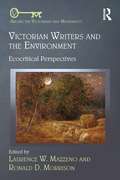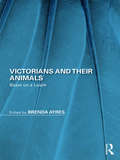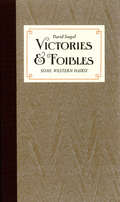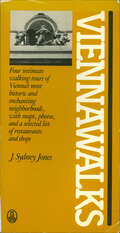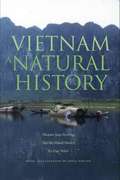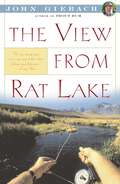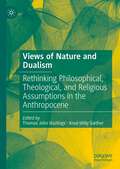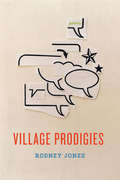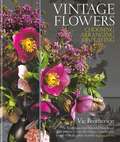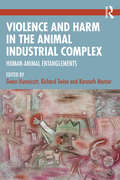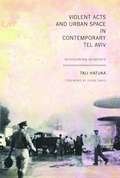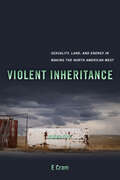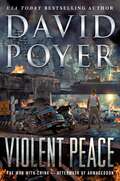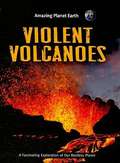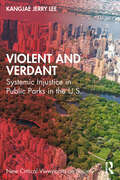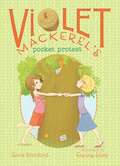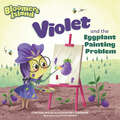- Table View
- List View
Victorian Writers and the Environment: Ecocritical Perspectives (Among the Victorians and Modernists)
by Laurence W. Mazzeno and Ronald D. MorrisonApplying ecocritical theory to the work of Victorian writers, this collection explores what a diversity of ecocritical approaches can offer students and scholars of Victorian literature, at the same time that it critiques the general effectiveness of ecocritical theory. Interdisciplinary in their approach, the essays take up questions related to the nonhuman, botany, landscape, evolutionary science, and religion. The contributors cast a wide net in terms of genre, analyzing novels, poetry, periodical works, botanical literature, life-writing, and essays. Focusing on a wide range of canonical and noncanonical writers, including Charles Dickens, the Brontes, John Ruskin, Christina Rossetti, Jane Webb Loudon, Anna Sewell, and Richard Jefferies, Victorian Writers and the Environment demonstrates the ways in which nineteenth-century authors engaged not only with humans’ interaction with the environment during the Victorian period, but also how some authors anticipated more recent attitudes toward the environment.
Victorians and Their Animals: Beast on a Leash
by Brenda AyresThis book, Victorians and Their Animals: Beast on a Leash, investigates the notion that British Victorians did see themselves as naturally dominant species over other humans and over animals. They conscientiously, hegemonically were determined to rule those beneath them and the animal within themselves albeit with varying degrees of success and failure. The articles in this collection apply posthuman and other theories, including queer, postcolonialism, deconstruction, and Marxism, in their exploration of Victorian attitudes toward animals. They study the biopolitical relationships between human and nonhuman animals in several key Victorian literary works. Some of this book’s chapters deal with animal ethics and moral aesthetics. Also being studied is the representation of animals in several Victorian novels as narrative devices to signify class status and gender dynamics, either to iterate socially acceptable mores or to satirize hypocrisy or breach of behavior or to voice social protest. All of the chapters analyse the interdependence of people and animals during the nineteenth century.
Victories & Foibles: Some Western Haiku
by David SeegalThe following haiku verses, written in an American style, are departures from the exacting nature of this Japanese poem. <P><P>By relaxing the restraints upon subject and style, the American poet gains the opportunity to experiment with and to possibly enhance the classic European examples. Although Japanese savants differ about the precise poetics of haiku, they agree that these short poems, highly successful since the thirteenth century, should be composed of three lines, the first and last bearing five syllables and the second bearing seven syllables.Kyoto BuddhaHe of stone, I of flesh, yetIt is he who smilesthat make a book of rare appeal to the western reader.
Viennawalks: Four Intimate Walking Tours Of Vienna's Most Historic And Enchanting Neighborhoods
by J. Sydney JonesViennawalks by J. Sydney Jones is the classic walking guidebook of the Austrian capital from the Henry Holt Walks Series. It includes four intimate walking tours of Vienna's most historic and enchanting neighborhoods, with maps, photos, and a selected list of restaurants and shops.
Vietnam: A Natural History
by Eleanor Jane Sterling Le Duc Minh Martha Maud HurleyA country uncommonly rich in plants, animals, and natural habitats, the Socialist Republic of Vietnam shelters a significant portion of the world's biological diversity, including rare and unique organisms and an unusual mixture of tropical and temperate species. This book is the first comprehensive account of Vietnam's natural history in English. Illustrated with maps, photographs, and thirty-five original watercolor illustrations, the book offers a complete tour of the country's plants and animals along with a full discussion of the factors shaping their evolution and distribution. Separate chapters focus on northern, central, and southern Vietnam, regions that encompass tropics, subtropics, mountains, lowlands, wetland and river regions, delta and coastal areas, and offshore islands. The authors provide detailed descriptions of key natural areas to visit, where a traveler might explore limestone caves or glimpse some of the country's twenty-seven monkey and ape species and more than 850 bird species. The book also explores the long history of humans in the country, including the impact of the Vietnam-American War on plants and animals, and describes current efforts to conserve Vietnam's complex, fragile, and widely threatened biodiversity.
View From Rat Lake (John Gierach's Fly-fishing Library)
by John GierachBrilliant, witty, perceptive essays about fly-fishing, the natural world, and life in general by the acknowledged master of fishing writers.“In the world of fishing there are magic phrases that are guaranteed to summon the demon. Among them are: ‘remote trout lake,’ ‘fish up to 13 pounds,’ ‘the place the guides fish on their days off,’” writes John Gierach in this wonderful collection of thirteen essays inspired by a fishing trip to Rat Lake, a remote body of water in Montana. Once again John Gierach does what he does best—explain the peculiarities of the fishing life in a way that will amuse novices and seasoned fly fishers alike. The View from Rat Lake deftly examines man in nature and nature in man, the pleasures of fishing the high country, and the high and low comedy that occasionally overcomes even the best-planned fishing trip. Some typically sage observations from The View from Rat Lake: “One of the things we truly fish for [is] an occasion for self-congratulation.”“In every catch-and-release fisherman’s past there is an old black frying pan.”“We . . . believe that a 12-inch trout caught on a dry fly is four inches longer than a 12-inch trout caught on a nymph or streamer.”
Views of Nature and Dualism: Rethinking Philosophical, Theological, and Religious Assumptions in the Anthropocene
by Knut-Willy Sæther Thomas John HastingsIn the face of the anthropogenic threats to the singular planetary habitat we share with other human beings and non-human species, humanities scholars feel a renewed sense of urgency 1) to acknowledge the ways our species has funded particular histories of environmental exploitation, alienation, and collapse, 2) to unpack inherited assumptions that impact our views of nature and interspecies relations, and 3) to suggest ways of thinking and acting that seek to repair the damage and promote mutual flourishing for all of earth inhabitants. This volume brings together scholars in philosophy, theology, and religion who take up this urgent ethical task from a broad range of perspectives and locations.
Villa Victoria: The Transformation of Social Capital in a Boston Barrio
by Mario Luis SmallFor decades now, scholars and politicians alike have argued that the concentration of poverty in city housing projects would produce distrust, alienation, apathy, and social isolation--the disappearance of what sociologists call social capital. But relatively few have examined precisely how such poverty affects social capital or have considered for what reasons living in a poor neighborhood results in such undesirable effects. This book examines a neglected Puerto Rican enclave in Boston to consider the pros and cons of social scientific thinking about the true nature of ghettos in America. Mario Luis Small dismantles the theory that poor urban neighborhoods are inevitably deprived of social capital. He shows that the conditions specified in this theory are vaguely defined and variable among poor communities. According to Small, structural conditions such as unemployment or a failed system of familial relations must be acknowledged as affecting the urban poor, but individual motivations and the importance of timing must be considered as well. Brimming with fresh theoretical insights, Villa Victoria is an elegant work of sociology that will be essential to students of urban poverty.
Village Prodigies
by Rodney Jones“A novel in language as dense and lush and beautiful as poetry . . . [or] a book of poetry with the vivid characters and the narrative force of a novel? Whatever you care to call it, it’s a remarkable achievement.” — Richard Russo, Pulitzer Prize–winning author of Empire Falls Village Prodigies imagines the town of Cold Springs, Alabama, from 1950 to 2015 and unfurls its narrative reach as six boys—prodigies and swains—grow up and leave the familiarity of home and the rural South. Yet all prodigies, all memories, all stories inevitably loop back. Through a multiplicity of points of view and innovative forms, Rodney Jones plays with the contradictions in our experience of time, creating portals through which we travel between moments and characters, from the interior mind to the most exterior speech, from delusions to rational thought. We experience Alzheimer’s and its effect on family, listen to family lore and read family Facebook posts, relive war, and revive half-forgotten folktales and video games. In this deep examination of personal and communal memory, Jones blurs the lines between analog and digital, poetry and prose.
Villager Jim's Bobbin Robin
by Villager JimOver many years, Villager Jim has gained the trust of a number of special birds and animals who have gradually taken it as second nature that a member of their own small world is a large chap with a camera!Bobbin Robin and her friends have a huge social media audience, with tens of thousands of viewers following her weekly adventures from the RSPB and on Facebook.Bobbin the robin has now become rather adept at posing for Jim, perching on various platforms for wherever Jim sits in his garden.Open up the book to see the daily goings-on of these wildlife friends in some of Jims very best pictures taken in this beautiful setting. They illustrate the close relationship Jim has formed with Bobbin and her friends.Jims lively captions express the mood and spontaneous character of each individual shot and are an essential element of what makes his pictures so special.
Villager Jim's Highland Cows
by Villager JimHugely charismatic, the Highland cattle breed is the focus of this photographic tribute to one of Britains most popular farm animals. These long-horned, curly coated cows are amongst the many now famous subjects featured in Villager Jims daily online photographic adventures, which have gained nearly 200,000 followers.Jim often wanders amongst the herds throughout the seasons, taking shots from many different angles as they graze on moorland, heathland, woodland copses and lush green farmland. Getting close to one to photograph is always a respectful journey; although they are normally very peaceful animals, Jim is always mindful to stay within their field of view and not invade their space too much.Despite rarely seeing their eyes, many of Jims shots have a comedy element to them, with the cows fondness for constant nose cleaning and their serious but amusing expressions semi-hidden behind masses of tangly hair.Through this book, Jim is very proud to help grow the following for this most beautiful breed of cattle.
Vintage Camper Trailer Rallies
by Paul Lacitinola Caroline LacitinolaA celebration of vintage midcentury trailers and the people that love them. This follow-up to the authors&’ Vintage Camper Trailers focuses on trailer rallies, events where hundreds of vintage trailers aficionados come together to show off their trailers and share their love of the hobby. It features hundreds of new photos of trailerites and their trailers, along with the fun and festivities that occur at the rallies. Also included are a history of camper trailers, along with information on the major trailer hobby groups, such as Tin Can Tourists, the Wally Byam Airstream Club, and Sisters on the Fly, and tips on how to plan and organize your own rallies and events, based on the authors&’ own first-hand experience.
Vintage Flowers
by Vic BrothersonBeautiful and romantic, Vic Brotherson's flower arrangements focus on traditional, seasonal blooms and foliage, such as alchemilla, lavender, hellebore, peonies and hydrangeas, and perfectly match the vintage pitchers, planters, old glass and retro, charity-shop finds she uses both for displays and as a major source of inspiration. From simple posies to glorious garlands and stunning centrepieces for a Christmas banquet, Vintage Flowers demonstrates just how easy it is to transform a handful of fresh cuttings into arrangements that instantly feel at home and complement the look of a room. Accompanied by step-by-step instructions on using florist foam and chicken wire to making a garland, wreath and hand-tied bunch, plus tips on how to select and condition flowers for longevity, how to pin the perfect corsage, wiring flowers for your hair and how to get the most from your budget, Vintage Flowers promises fabulous results every time.
Vintage Lopez
by Barry Lopez"Lopez has such great narrative skill and uses his words so carefully the simple intensity is often nearly overwhelming. " --The Oregonian. Barry Lopez is an unparalleled explorer of the relationship between humanity and nature, one he limns in prose as beautiful as it is economical. His essays and short fiction have appeared everywhere from Outside to Harper's and The Paris Review. He is the winner of a 1986 National Book Award for his bestselling Arctic Dreams. Vintage Lopez is divided into two parts, nonfiction and fiction. It includes "Landscape and Narrative"; the prologue to Arctic Dreams; and such classic short stories "The Entreaty of the Wiideema" and "The Mappist." Also included, for the first time in book form, the essay "The Naturalist."
Vintage Wedding Flowers
by Vic BrothersonVic Brotherson believes that wedding flowers should express the character and individuality of a couple. In Vintage Wedding Flowers she provides ideas and inspiration for everything from bouquets to buttonholes, to table dressings, and corsages - and to suit all possible budgets. Chapters include Classic Flora, which considers traditional white and green displays; Graceful Rose, which has soft and graceful arrangements; Crazy Iris, for the more adventurous bride; and Romantic Violet, for those wanting a magical, dreamy feel. Full of beautifully shot colour photographs and helpful, step-by-step instructions, Vintage Wedding Flowers helps you create beautiful, timeless wedding flowers from simple blooms whether you plan to do the flowers yourself or employ someone to do them for you.
Violence and Harm in the Animal Industrial Complex: Human-Animal Entanglements
by Richard Twine Gwen Hunnicutt Kenneth MentorThis book grapples with multispecies violent exploitations embedded in corridors of power within the animal-industrial complex (A-IC). The A-IC is a useful framework for understanding how exploitative human-animal relations are central to capitalist relations and profit accumulation. ‘A-IC-related-violence’ – killing animals for economic gain – has a ripple effect which results in profound consequences for humans as well.This collection of international scholarship explores topics as varied as how A-IC-related-violence is reproduced and sustained through rapidly changing discursive strategies, ideological architecture, and particular cultural forms that elide and legitimize animal cruelty. Several chapters expose collusion between governments, corporations, and academia as central to maintaining dominance of A-IC-related-violence. Other scholars explore the trouble with making the conditions of “meat” production visible – of de-fetishizing meat commodities. The scholarship critically explores dynamic components of an apparatus that enables A-IC-related-violence and harm but is situated within the capitalist order and charts A-IC-related-violence as the key profit-generating practice in select domains of the A-IC.The book unmasks inherent cruelties in a proliferation of social forms that ultimately reflect a socioeconomic system that centralizes capitalist life characterized by endless growth, competitiveness, and profligate consumption. This is essential reading for those engaged in critical criminology, green criminology, violence studies, peace and conflict studies, critical animal studies, or animal rights-oriented scholars.
Violent Acts And Urban Space In Contemporary Tel Aviv
by Tali HatukaViolent acts over the past fifteen years have profoundly altered civil rituals, cultural identity, and the meaning of place in Tel Aviv. Three events in particular have shed light on the global rule of urban space in the struggle for territory, resources, and power: the assassination of Prime Minister Rabin in 1995 in the city council square; the suicidal bombing at the Dolphinarium Discothèque along the shoreline in 2001; and bombings in the Neve Shaanan neighbourhood in 2003. Tali Hatuka uses an interdisciplinary framework of urban theory and socio-political theory to shed light on the discourse regarding violent events to include an analysis of the physical space where these events take place. She exposes the complex relationships among local groups, the state, and the city, challenging the national discourse by offering a fresh interpretation of contesting forces and their effect on the urban environment. Perhaps the most valuable contribution of this book is its critical assessment of the current Israeli reality, which is affected by violent events that continually alter the everyday life of its citizens. Although these events have been widely publicized by the media, there is scant literature focusing on their impact on the urban spaces where people live and meet. In addition, Hatuka shows how socio-political events become crucial defining moments in contemporary lived experience, allowing us to examine universal questions about the way democracy, ideology, and memory are manifested in the city.
Violent Inheritance: Sexuality, Land, and Energy in Making the North American West (Environmental Communication, Power, and Culture #3)
by E CramViolent Inheritance deepens the analysis of settler colonialism's endurance in the North American West and how infrastructures that ground sexual modernity are both reproduced and challenged by publics who have inherited them. E Cram redefines sexual modernity through extractivism, wherein sexuality functions to extract value from life including land, air, minerals, and bodies. Analyzing struggles over memory cultures through the region's land use controversies at the turn of and well into the twentieth century, Cram unpacks the consequences of western settlement and the energy regimes that fueled it. Transfusing queer eco-criticism with archival and ethnographic research, Cram reconstructs the linkages—"land lines"—between infrastructure, violence, sexuality, and energy and shows how racialized sexual knowledges cultivated settler colonial cultures of both innervation and enervation. From the residential school system to elite health seekers desiring the "electric" climates of the Rocky Mountains to the wartime incarceration of Japanese Americans, Cram demonstrates how the environment promised to some individuals access to vital energy and to others the exhaustion of populations through state violence and racial capitalism. Grappling with these land lines, Cram insists, helps interrogate regimes of value and build otherwise unrealized connections between queer studies and the environmental and energy humanities.
Violent Peace: The War with China: Aftermath of Armageddon (Dan Lenson Novels #20)
by David PoyerWorld War III is over… or is it? Superpowers race to fill the postwar power vacuum in this page-turning thriller, the next in the Dan Lenson series.In the next installment of David Poyer’s critically-acclaimed series about war with China, mutual exhaustion after a massive nuclear exchange is giving way to a Violent Peace. While Admiral Dan Lenson motorcycles across a post-Armageddon US in search of his missing daughter, his wife Blair Titus lands in a spookily deserted, riot-torn Beijing to negotiate the reunification of Taiwan with the rest of China, and try to create a democratic government.But a CIA-sponsored Islamic insurgency in Xianjiang province is hurtling out of control. Andres Korzenowski, a young case officer, must decide whether ex-SEAL Master Chief Teddy Oberg—now the leader of a ruthless jihad—should be extracted, left in place, or terminated.Meanwhile, Captain Cheryl Staurulakis and USS Savo Island are recalled to sea, to forestall a Russian fleet intent on grabbing a resource-rich Manchuria.The violent and equivocal termination of the war between China and the Allies has brought not peace, but dangerous realignments in the endless game of great power chess. Will the end of one world war simply be the signal for the beginning of another?
Violent Volcanoes
by Terry JenningsDiscusses volcanoes and how they work using statistics and case studies.
Violent and Verdant: Systemic Injustice in Public Parks in the U.S. (New Critical Viewpoints on Society)
by KangJae Jerry LeePublic parks in the U.S. are one of the most contentious and paradoxical places. Many Americans believe public parks are encapsulations of nature, promoters of health, and embodiments of egalitarianism and democracy, providing a wide range of health, economic, cultural, and social benefits to users. Yet, the historical reality of American public parks has been riddled with greed, hypocrisy, prejudice, and ulterior motives of the rich and powerful. Numerous people have been displaced, exploited, and even killed because of public parks.Drawing from multiple disciplines such as sociology, history, geography, urban planning, environmental science, and leisure studies, Violent and Verdant: Systemic Injustice in Public Parks in the U.S. takes a two- pronged approach to provide critical and fresh insights on public parks in the U.S. It looks back, illuminating how parks have been sites of enduring violence and oppression. But it also looks forward, offering practical strategies and philosophical reimaginations of parks’ conception, development, and management.
Violet Mackerel's Pocket Protest (Violet Mackerel)
by Elanna Allen Anna BranfordIn this sixth story of the Violet Mackerel series, Violet and Rose start a very small protest to make a very big impact.Violet and Rose have shared their best secrets under the big oak tree in Clover Park. And they have found some very good small things there too. So when Johnson's Tree Services stomps in and posts a sign that says PUBLIC NOTICE-TREE REMOVAL, they know that they must do something to stop them. When their first protest washes away in the rain, Violet and Rose feel discouraged. But then they realize that the sort of people who care most about small things, like birds not having nests and people not having a place to collect acorns, might also be the sort of people who notice very small protests. And that gives them a quite brilliant idea, one that just might save their tree, on behalf of all the small things--and small people--who love it.
Violet and the Eggplant Painting Problem: Bloomers Island (Bloomers Island #4)
by Cynthia WylieIn Violet and the Eggplant Painting Problem, Professor Sage holds a contest between the young Bloomers, where each must choose their favorite vegetable to grow and care for. Here, young readers are introduced to the character of Violet, a painter who loves purple. So of course she chooses to grow eggplants, and decides to make paintings of them to track their progress. But she runs into a problem—there’s no more purple paint! Violet quickly learns that she can gather blackberries to make her own purple paint, and she is able to paint her vegetables after all.Bloomers Island Garden of Stories picture books take young readers and listeners to Bloomers Island to experience the world of plants, flowers, and gardens through lively stories and lush illustrations.
